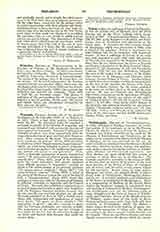

Trichinopoly, Diocese of’ (TRICHINOPOLITAN.), in India, suffragan of Bombay, comprises the southeast portion of the peninsula as far as the Western Ghauts, by which it is separated from the dioceses of Verapoly and Quilon; bounded on the north by the Dioceses of Kumbakonam and Coimbatore, on the northeast by a portion of the Diocese of Saint Thomas of Mylapur, on the east and south by the sea. In order to facilitate administration the diocese is divided into three districts, northern, central, and southern, each under a superior having his residence at Trichinopoly, Madura, and Palamcottah respectively; and these districts are again subdivided into pangus or sections, of which there are in all fifty-two. The Catholic population, according to the census of 1907, is 245,255, who are served by 60 priests of the Toulouse province of the Society of Jesus (41 European and 19 native) and 19 native secular priests, helped by 156 catechists. Besides these, 53 other priests, European and native, are engaged chiefly in educational work at Trichinopoly, Shembaganur, Palamcottah, etc. A novitiate, juniorate, and scholasticate of the Society is established at Shembaganur. There is a congregation of Brothers of the Sacred Heart (native lay brothers) engaged in catechetical work and teaching at Palamcottah, Madura, Panchampetti, and Trichinopoly, and also the following orders of nuns: Daughters of the Cross of Annecy at Trichinopoly and Tuticorin; Sisters of St. Joseph of Lyons at Madura; native nuns of Our Lady of Seven Dolors and native nuns of St. Anna, both with their novitiate at Trichinopoly; finally the Oblates—native women devoted to the baptism of pagan children and the instruction of village girls. The places of worship in the diocese amount to 282 churches and 811 chapels. There are also fifteen churches and some chapels scattered over the diocese which (by exemption) belong to the padroado jurisdiction of the Diocese of Saint Thomas of Mylapur.
HISTORY.—The present diocese comprises a large portion of the ancient Madura mission, so that down to the year 1836 its history will be found under MADURA MISSION. In that year the district was once more entrusted to the Society of Jesus, and its first vicar Apostolic was appointed in 1845. In 1886, on the establishment of the hierarchy, the vicariate became a diocese suffragan of Pondicherry; but in 1893 it was made suffragan of Bombay, as it still remains. Succession of prelates: Alexis Canoz, S.J., vicar Apostolic 1847, became first bishop in 1887, died in 1888; John Mary Barthe, S.J., in 1890, resigned on account of failing sight in 1909; A. Faisandier, S.J., coadjutor bishop from 1909. Educational institutions for boys: St. Joseph‘s College, Trichinopoly, first opened at Negapatam in 1846, transferred to Trichinopoly in 1883, with about 1800 pupils, prepares students for the degree of M. A. in Madras University; boarding-house for native Catholic boys; ecclesiastical seminary to prepare boys for one at Kandy; lower secondary school for Europeans and Eurasians and seven primary schools for natives, with total of 600 pupils, all at Trichinopoly; St. Xavier’s High School, Palamcottah, with boarding-house and St. Anthony’s primary school; St. Xavier’s High School, Tuticorin; St. Mary’s High School, Madura; lower secondary schools at Palamcottah, Dindigul, Uttamplayama; industrial schools at Trichonopoly, Irudaiyakulam, and Adaikalaburam; training schools for teachers at the same places; primary schools in the diocese number 260, with 11,027 pupils. For girls: St. Joseph‘s High School and lower secondary school, Trichinopoly, for European and Eurasian girls, both under Daughters of the Cross; three secondary schools for native girls (Trichinopoly) under Sisters of Our Lady of Seven Dolors, also training schools for mistresses; lower secondary schools at Palamcottah, Madura, Tuticorin, Vadakangulam, Manapad, Satankulam; primary schools at Dindigul, Sarakanai, and several other villages; industrial school (Tuticorin) under Daughters of the Cross. Various institutions: orphanages for children born of pagan parents at Trichinopoly, Madura, and Adaikalaburam, and one for girls at Palamcottah; dispensaries in five places; asylums for native widows at Trichinopoly, Sarakanai, Adaikalaburam, and for Brahmin widows at Trichinopoly; St. Mary’s Tope, a settlement in Trichinopoly for Brahmin converts, opened in 1893, has (1912) 45 residents; catechumenates for men and women in three places, besides associations of voluntary catechists who give their leisure time to teaching on Sundays and feasts; St. Joseph‘s College Press, which publishes the “Tamil Messenger of the S. Heart”, the “Morning Star”, devotional books, etc. There are over 100 sodalities in the diocese.
R. HULL

